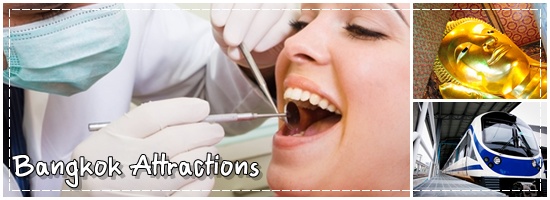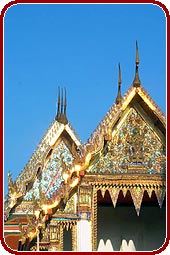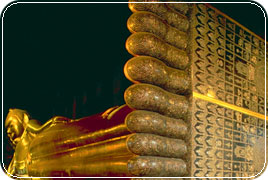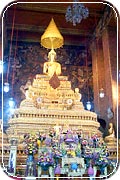
Wat Pho or Temple of the Reclining Buddha
 Wat
Pho or wat Phra Chetuphon, the oldest
and largest wat in Bangkok, was built in
the 16th century during the Ayutthaya
period. The tempel was almost completely
rebuilt in 1781 by King Rama I and again
a major restoration in 1839 which took
seventeen years to complete by King Rama
III. Wat
Pho or wat Phra Chetuphon, the oldest
and largest wat in Bangkok, was built in
the 16th century during the Ayutthaya
period. The tempel was almost completely
rebuilt in 1781 by King Rama I and again
a major restoration in 1839 which took
seventeen years to complete by King Rama
III.
It features the largest reclining Buddha
in Bangkok and the largest collection of
Buddha images in Thailand. Wat Pho came
regarded as 'the
first university in Thailand'
when King Rama III ordered texts to be
inscribed on stone slabs around the
temple which people can learn and read
from.
The main attraction of Wat Pho is the
famous 'Reclining
Buddha'. Built in the reign
of King Rama III, this tremendous Buddha
image is 46 metres (153 feet) long and
15 metres (50 feet) high. The statue was
to representing the Lord Buddha trying
to overwhelm one of the powerful demons
and to convince him that his power is
not the supreme. The figure is modelled
out of plaster around a brick core and
finished in gold leaf. Mother-of-pearl
inlay ornaments the eyes and feet
displaying 108 different auspicious
characteristics of a Buddha. The
building was built later to cover the
Buddha image.

The other important building in the
compound is the main chapel or Ubosot.
Originally constructed in the reign of
King Rama I, the Ubosot was considerably
enlarged in the reign of King Rama III.
The structure is extended with a
three-tiered roof down to meet the
colonnade around the building. Inside
the Ubosot houses an ayutthaya-style
bronze Buddha image in the attitude of
meditation. King Rama I gave this image
a name of Phra
Puttha Devapatimok. The
pedestal of this image contains the
crematory ashes of King Rama I, interred
in the reign of King Rama IV
One of the images on display in the four
Wihans surrounding the main Ubosot in
the eastern part of the compound is also
interesting. Phra Puttha Loknat Sasadajan,
a tallest bronze standing Buddha image,
stands in an alcove of the east Wihan.
The image was formerly at Wat Phra Si
Sanphet in Ayutthaya. It was brought to
Bangkok together with Phra Si Sanphet
which is now kept inside the great stupa
of King Rama I.
The galleries extending between the four
Wihans feature no less than 394 gilded
Buddha images. This images were selected
from among 1,200 that were brought down
to Bangkok from either destroyed or
deserted temples in the country during
the destructive war.

Phra Puttha
Devapatimakorn |

Phra Puttha Loknat Sasadajan |

Reclining Buddha |
Just outside the west Wihan, four great
stupas called Phra Maha Chedi can be found
each at 41 metres high. The four great
stupas were built on three separate
occasions. The first stupa was built in
the reign of King Rama I to contain
Buddha image, Phra Si Sanphet. The
second occasion was happened when King
Rama III built 2 more stupas on each
side of the first one. The white glazed
tile on the right was for King Rama II
while the yellow one on the left was for
his own behalf. The last great stupa in
blue tile was built by King Rama IV to
commemorate his own reign before he
ordered that the future King shouldn't
built any more great stupa in this
already crowded temple.
Apart from the four great stupas, there
are 4 groups of five stupas which each
group stays on the same pedestal and 71
small line stupas. There are a total of 95 stupas of various sizes in the temple compound.
Around the terrace outside the gallery
are found 26
rockeries. There were made up
from stones moved from the garden in the
Grand Palace. Two rockeries are of
special interest. The one in front of
the great stupas has a 'Siva Lingam'
while another miniature rock hill
features the 'Rishi' figures in posture
of self massage. Apart from the
rockeries, Wat Pho abounds in stone
figures from China. The figures have
been used as ballast of the sail when
intensive trade with China were made
during the reign of King Rama III.
Wat Pho is also the national
headquarters for the teaching and
preservation of traditional Thai
medicine, including Thai massage. A
massage school convenes in the
afternoons at the eastern end of the
compound. A Thai traditional message
costs 250 baht per hour and 150 baht for
a half-hour. The massage courses from
five to 10-day courses can be attended
for 7,000 Baht. |